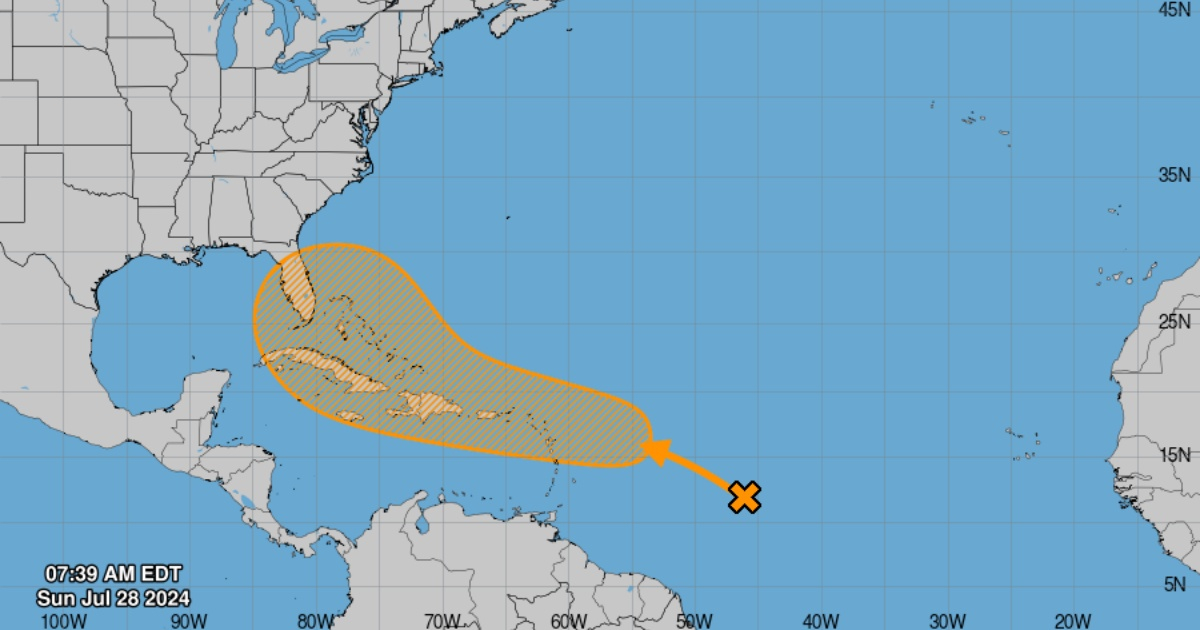The National Hurricane Center (NHC) has recently raised the probability to 40% that a tropical depression could form within the next seven days near the Leeward Islands, the Greater Antilles, or the southwestern Atlantic. This alert is particularly crucial for Cuba, which needs to closely monitor the development of this weather system.
"An area of disturbed weather over the central tropical Atlantic Ocean is expected to interact with an approaching tropical wave over the next few days," the NHC stated in its 8 a.m. (Miami time) bulletin on Sunday. "Environmental conditions are forecast to become conducive for some development in a day or two, and a tropical depression could form by mid-week while the system is near or over the northern Leeward Islands, the Greater Antilles, or the southwestern Atlantic Ocean," the agency concluded.
Cuban meteorologist Raydel Sánchez emphasized in a Facebook post that although current conditions are not favorable for development, "they could become somewhat more favorable as this system moves further west." He also reiterated that the highlighted area in the forecasts is not a storm or hurricane track cone but rather an area of probability where the system could be forming.
Probabilities may change in the coming hours, potentially increasing or decreasing depending on how conditions evolve for the formation of the system.
CSU Hurricane Forecast Update
Earlier this month, meteorologists from the Colorado State University (CSU) in the United States updated their initial hurricane forecast for the current Atlantic hurricane season. They now anticipate 25 named storms and 12 hurricanes, six of which could be major hurricanes.
Just a day after Beryl struck the state of Texas as a Category 1 hurricane early Monday morning, leaving destruction and fatalities in its wake, the university's Department of Atmospheric Science added two named storms and one major hurricane to their June forecast.
This pioneering group in seasonal hurricane prediction updated their forecast based on the increased average sea surface temperatures in the main development region of the tropical Atlantic and the Caribbean, which are near record warm levels. These temperatures "provide a much more conducive dynamic and thermodynamic environment for the formation and intensification of hurricanes," the university stated on its website.
Beryl set records by becoming the first hurricane to reach Category 4 and Category 5 on the Saffir-Simpson scale so early in the 2024 hurricane season, which began on June 1 and ends on November 30.
Colorado State University is not the first organization to predict an above-average hurricane season. In May, the National Oceanic and Atmospheric Administration (NOAA) of the United States forecasted a more active season than usual, with between 17 and 25 named storms and up to 13 hurricanes, seven of which could be major hurricanes.
FAQs on Tropical Depression Formation and Hurricane Season Predictions
The following questions and answers provide further insights into the tropical depression formation and updated hurricane season predictions.
What is the current probability of a tropical depression forming in the Caribbean?
The National Hurricane Center (NHC) has raised the probability to 40% that a tropical depression could form within the next seven days near the Leeward Islands, the Greater Antilles, or the southwestern Atlantic.
Why are current sea surface temperatures significant for hurricane formation?
Increased sea surface temperatures in the main development region of the tropical Atlantic and the Caribbean are near record warm levels, providing a much more conducive dynamic and thermodynamic environment for the formation and intensification of hurricanes.
How has the forecast for the current hurricane season changed?
Colorado State University has updated its forecast to anticipate 25 named storms and 12 hurricanes, six of which could be major hurricanes. This is an increase from their initial prediction.
